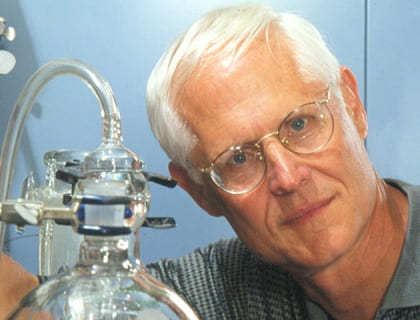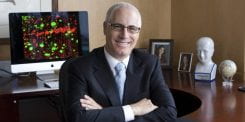The maestro of molecules
Larry Overman conducts research in more than one sense of the word: In the creation of new molecules, he orchestrates chemical reactions to produce symphonic results

The world we live in is saturated with messages about chemistry – the bottle of pills with its list of multisyllabic ingredients … the gas pump announcing additives and ratings … sleek ads for cosmetics containing the newest “organic” smoothers, tighteners and emollients. Chemicals seem as common a part of our world as weather.
Why then should it be so challenging for the people who work in Larry Overman’s organic chemistry lab to explain to a non-chemist what they do?
“It’s like cooking,” says graduate student Artie Brosius. “Many organic chemists love to cook and it’s not surprising why … basically you’re putting things in a pot, mixing them up and seeing what comes out.”
Overman himself, a master in the field as acknowledged by his election last year to the National Academy of Sciences, describes his work with hesitation. English seems not quite the proper language for the level of reality he deals with.
It may be closer to art. Overman says he frequently feels he has more in common with “people in fine arts” than with many other scientists. And it is the language of art, the vocabulary of creativity, he tends to employ. In his laboratory, molecules are “sculpted” and chemical reactions are “orchestrated,” producing results that are “like a symphony.”
Some chemical structures, particularly unprecedented new molecular formations that are turning up in marine species such as sponges, remind him of his favorite artist. He gestures toward a print on his office wall.
“Just like a Chagall painting could strike you – this artist put something on canvas in a completely new way. These molecules from the ocean have the same effect. They have a combination of atoms, a connectivity, that is unique, beautiful and provocative. And in some cases, they are potentially useful – although I’d be turned on by some of them even if they were of no immediate use, because of their beauty as chemical structures.”
It’s an aesthetic reaction to a research endeavor of considerable practical importance. Overman and the 30 people on his team work at one of the most fundamental levels of chemistry,creating molecules – both those that have never existed before and ones identical to those found in nature. They search for ways to build complex compounds from inexpensive precursors, particularly molecules that show promise as medicines. And they construct complex molecules of less significance per se, but which serve as focal points for developing new chemical tools – in Overman’s case the chemical reactions that convert one molecule to another.
Overman knows his work would be easier to understand if it were closely related to, say, a cure for Alzheimer’s disease. “But we are really much more out in front than that,” he explains.
“What’s going on in my lab, and many innovative university research labs around the world, are discoveries that are often far out in front of commercialization–the pie-in-the- sky, the really new, the very high-risk things – that will hopefully stimulate medical therapies 20 years from now.
“Much of academic research is at the very most exploratory and really is about developing tools that others will use,” he continues. “For example, we’re developing chemical tools that allow people to build molecules in ways they couldn’t before.”
Pressed for an analogy, Overman offers this: “Say you are building the Empire State Building. We would be working on two fronts – to provide new, economical building materials, and outline new strategies for their use that hopefully will allow you to complete construction in one-tenth the time at one-tenth the cost.”
The connection between Overman’s lab and a bottle of pills is remote but real. The process of bringing a new medicine to the market can take 20 years and the work of hundreds of scientists.
“Almost all, except for a few so-called natural products, of the pharmacopoeia used in the United States have come from a process in which hundreds of thousands of compounds may have been examined. Chemists in the pharmaceutical industry modify the structure of initial compounds, and in collaboration with biologists see whether these modifications increase efficacy and decrease side effects – the key issues involved in developing safe medicines. In any medication you buy, there’s a long history of chemical structure modification. It’s like a long, winding river with a lot of tributaries.
“It’s very satisfying to know that chemistry discovered in my lab has undoubtedly been involved in the evolution of several pharmaceuticals that have been commercialized in the last ten years.”
Pharmaceutical companies recognize the value and quality of Overman’s work both by providing unrestricted financial support and by lining up to hire his graduates. Dr. Conrad Kowalski, director of synthetic chemistry at SmithKline Beecham in Philadelphia, says his chemists rely on Overman’s help and advice.
“He has a lot of creative, original approaches to important problems in chemistry,” Kowalski says. “He’s been very helpful to us over the years with both specific suggestions and helping people here come to the best conclusions themselves.”
Although openings in Overman’s lab are much in demand, Overman allows some of them to go to undergraduates. Chemists graduating with a bachelor’s degree can readily move into a well-paying position in industry, and those who instead pursue academic research have gained valuable experience. Talal Nasser, an 18-year-old junior working in Overman’s lab, said that in assisting the research of a postdoctoral student, he’s been learning chemistry and how to use research tools.
“It’s actually paying off now,” Nasser said. “I’m working on a new project, trying new reactions.”
Overman’s office, like that of many chemists, is scattered with Tinkertoy-like models of molecules, in his case predominantly black (carbon) and blue (nitrogen) links. His lab, he says, has become particularly well known for inventing new reactions that incorporate nitrogen. He picks up a model and turns it to illustrate his point.
“Some scientists look at a structure and think, ‘How can I bundle this together to make something complex and bigger?’ Synthetic chemists, given a complex structure, think ‘How can I break it down into simple, inexpensive pieces?”’
Overman’s vision is, indeed must be, focused on the invisible – the connections among atoms that his models illustrate.But there’s another scale to his work that is global and, to him, very exciting. He and other chemists throughout the world are exploring a new generation of chemicals that come from the ocean. Marine lifeforms, particularly sponges, are showing promising antibiotic, anticancer and antifungal properties, and some medicines derived from them already are in clinical trials. The development coincides with one of Overman’s strong interests; he’s been a recreational diver for more than 20 years.
“Historically, most medicines came initially from plants –morphine, for example, came from poppies. With Fleming’s discovery of penicillin, we entered an era when the vast majority of antimicrobial, antibiotic, antibacterial agents came from microorganisms.
“Here you have almost the perfect window of opportunity for a laboratory like mine because you have fascinating new, unique chemical structures from the ocean that may have promising biological activities,” Overman said.
If this promise is fulfilled and new medicines are to be created, the marine source could be farmed – and there is experimentation in this direction – or the chemicals could be synthesized using procedures developed in labs like Overman’s. This work is already under way and, according to Overman, synthesis has been successful in many cases. In a few instances, “we’ve been successful in achieving synthesis efficiently enough to impact the world’s access to these materials,” he says. “In the area of some very complex alkaloids that come from sponges, we’ve recently developed a synthetic approach that promises to be quite practical. It could eventually be scaled up by industry to access the amounts needed for commercialization.”
Overman’s election in 1996 to the National Academy of Sciences was gratifying, he says, and “probably the highest–realistic–honor you can aspire to” as a scientist. Reminders of an honor that Overman thinks scientists can’t realistically hope for surround him. His laboratory is located in Frederick Reines Hall (formerly Physical Sciences II), and the large National Academy of Sciences diploma on his office wall bears the signature of F. Sherwood Rowland. The UCI faculty members are both 1995 Nobel laureates – Reines for physics, Rowland for chemistry. Overman says Rowland, an atmospheric chemist, has been a strongly supportive mentor to him for years.
The National Academy of Sciences, founded by Congress in 1863 to advise the federal government on science and technology, has 1,773 members, 16 of whom are from UCI. Overman is UCI’s newest member, and he considers the post a responsibility as well as an honor. Committee assignments will put him to work on questions of national science and research policy; a board he recently agreed to co-chair currently is studying whether taggants – tracing devices –should be added to explosives sold in the United States.
Overman intends to use his new standing to advocate for support of basic research that is “primarily creativity-driven, that has no immediate practical application in mind.” The foundation for Rowland’s discovery of the mechanism of atmospheric ozone depletion came from this type of research, he says, and so did today’s magnetic resonance imaging technology. It was this type of fundamental research, 10 and 20 years ago, that produced the discoveries that are being commercialized today.
Today, however, with federal research funding in decline, Overman believes there is the danger that too much of the money is going into “the tail end of the drug discovery process.” In contrast, the beginning phase of research, the creative exploring of new ideas, is becoming increasingly impoverished. “If we forget the front end,” he says, “we might do okay for a few years, but 10 years down the road the discoveries like those that are being commercialized today won’t be there.”
Overman is concerned, too, about declining federal support for science research. He says when he entered academia in 1971, about 45 percent of the grant applications recommended for funding actually received money; now federal allocations will pay for only about 20 percent of the applications that clear the approval process. With so few grants being funded, he says, a disproportionate number go to established scientists like him, with younger scientists working ever harder chasing dwindling dollars.
“Right now the United States should feel extremely challenged by what Japan is doing – doubling its basic research budget. There are labs in Japan working in areas similar to mine that have had infusions of millions of dollars in recent years from the Japanese government.”
This has important implications for the future of American science, Overman believes, because the technology of tomorrow will depend on the basic research of today. “Fundamental research, where one is trying to plug a hole that is unknown – how does something work, could we do this, could we make a molecule that has this bizarre shape? – could, 20 years down the road, be the foundation for something very important, yet completely unknown today.”

